THIS WAS NEVER MEANT TO BE SEEN” — ‘EVERYTHING WE THOUGHT WAS WRONG…’ Viral Clip Shows Charlie Kirk Collapsing From Behind — Candace Owens Releases New Evidence That Leaves Millions Frozen in Shock — A Mysterious Figure Appears in the Final Frames — And That Last Image Changes Everything.
For weeks, the whispers circled. For days, the speculation burned. And then — in a single viral clip that erupted across social media — everything the public thought they knew about Charlie Kirk’s final moments crumbled before their eyes.
The video, described by insiders as “the one piece of evidence they never wanted out,” is grainy, jarring, and impossible to dismiss. It shows Kirk collapsing — not from the angle we were told, not in the sequence we were promised, and most importantly,
not at the hands of the person everyone was told to blame.
Instead, the footage reveals something else entirely:
-
A collapse from behind, sudden and inexplicable.
-
A figure in the background, blurred but undeniably present.
-
And in the final frames, an image so haunting that millions of viewers claim they’ll never forget it.
Candace Owens, in her signature uncompromising style, has now gone public with the video — calling it “the clip that rewrites history.”
“This was never meant to be seen,” Owens told her audience in a fiery livestream that has already reached over 20 million views. “And yet, here it is. Watch it for yourself. Tell me the story you were fed still makes sense after this.”
The reaction? Immediate chaos.
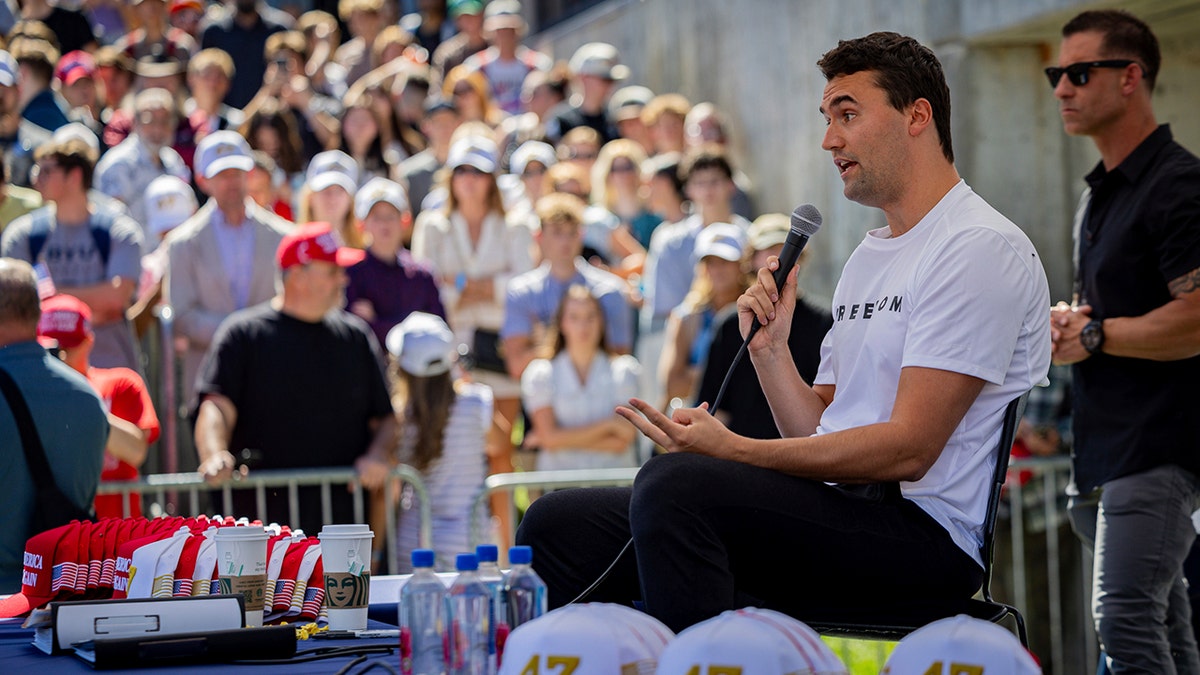
The Internet Erupts
Within minutes of the clip going live, hashtags like #CharlieKirkClip, #HiddenFrames, and #OwensLeak began trending worldwide.
Twitter (X) was ablaze with theories:
-
“That shadow in the corner — who IS that?!”
-
“If this is real, we’ve been lied to on a scale I can’t even comprehend.”
-
“The silence after he falls is the scariest part. Like they all knew what just happened.”
Facebook groups dedicated to “unanswered questions” about Kirk’s case lit up overnight with thousands of new members. TikTok creators slowed the video down frame-by-frame, circling the blurred figure that appears in the last seconds.
And YouTube? Flooded with breakdowns, reaction videos, and “evidence boards” connecting the dots between this new footage and the narrative the public was fed months ago.
One popular streamer summed it up bluntly:
“If this clip is legit, the official story isn’t just cracked. It’s obliterated.”
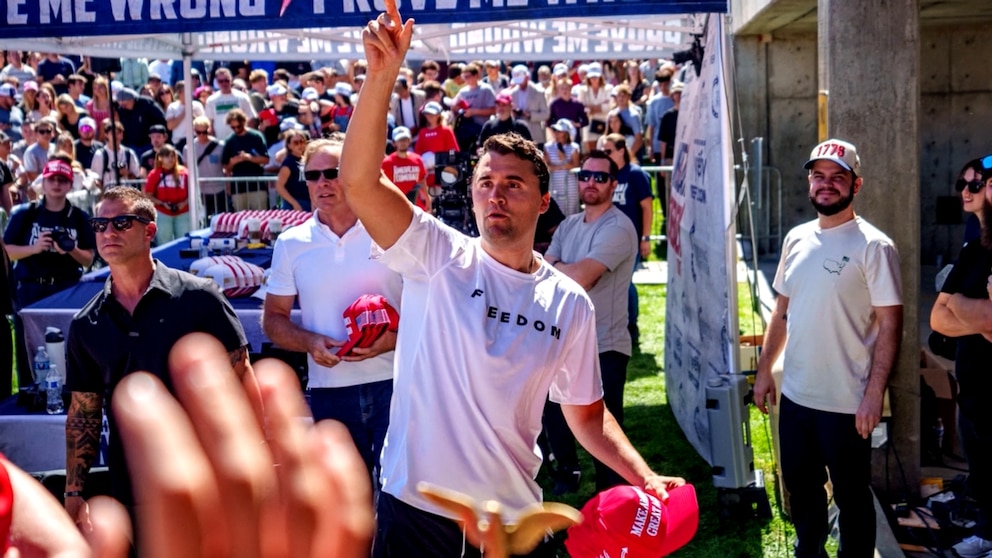
Candace Owens: “I Will Not Be Silent”
Owens herself wasted no time in fanning the flames. Appearing in a string of interviews across independent platforms, she doubled down on her claims:
“They buried this clip. They buried it because it shows something they can’t explain away. This isn’t a conspiracy theory. This is proof — hard proof — that the public narrative is a fabrication.”
Pressed to clarify what the “mysterious figure” in the final frames might mean, Owens was deliberately cagey:
“I’m not here to tell you who it is. I’m here to show you that it exists. You see the same thing I see. And you know, deep down, what that means.”
Her refusal to name names only fueled the speculation further. Some commentators suggested it was a political operative. Others whispered about financial backers pulling strings behind the scenes. Still others — the most conspiratorial voices online — claimed the figure was part of a staged operation from the very beginning.
Whatever the truth, Owens has made one thing clear: she intends to keep releasing evidence until the “entire machine comes crumbling down.”
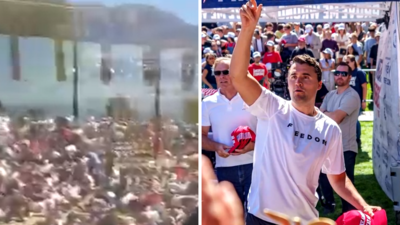
A Timeline Torn Apart
The significance of the video lies not just in what it shows, but in how it collides with the official timeline.
Authorities had always insisted Kirk’s collapse was the result of a direct confrontation, a sudden escalation that unfolded in plain sight. But the viral clip paints a very different picture:
-
The angle of the fall contradicts sworn testimony.
-
The audio in the background includes a voice that should not have been present.
-
The blurred figure is positioned exactly where “no one” was supposed to be.
And then comes the most haunting detail of all: the freeze-frame at the very end.
Insiders claim the last image — the one that has now circulated across every corner of the internet — was intentionally cut from the version shown to investigators. Why? Because it raises a question so explosive that even the most seasoned analysts hesitate to ask it:
👉 Was Kirk’s collapse orchestrated?
The Public Demands Answers
By the morning after Owens’ release, pressure on officials had reached a boiling point. Members of Congress were bombarded with calls demanding an inquiry. Protesters gathered outside courthouse steps holding signs that read:
Even mainstream outlets, which had largely stayed silent on Owens’ campaign up until now, were forced to acknowledge the story. CNN referred to the video as “a troubling piece of footage now impossible to ignore.” The New York Times cautiously noted that “the leaked clip raises new questions that authorities will need to address.”
But the loudest voices weren’t in newsrooms — they were on the streets, on TikTok, on Twitter. Ordinary people who had never cared about the Kirk case before were suddenly glued to their screens, watching and rewatching the final frames.
One woman, interviewed outside a rally in Texas, summed up the collective mood:
“They lied to us once. How many more times are we supposed to believe them? This clip proves we’ve been kept in the dark.”

Behind the Curtain: The Leaks, the Fights, and the Shadows
If Part 1 of the viral clip was the explosion, Part 2 is the fallout.
Because the footage didn’t just break the internet — it cracked open a vault of long-suppressed whispers.
Suddenly, insiders who had remained quiet for months began talking. Anonymous messages slipped to journalists, encrypted files appeared in Telegram groups, and ex-staffers hinted they had “more to share if the world is ready.”
One such leak described a series of secret meetings held in the days before Kirk’s collapse. According to documents now circulating online, certain individuals close to the case had foreknowledge of “an incident that would change everything.”
Could that line have referred to Kirk’s final moments?
Or was it the vague paranoia of political operators covering their tracks?
Either way, the connection between these leaks and the viral video proved too much to ignore.
The Battle for the Narrative
In the hours after the clip surfaced, a full-scale information war erupted.
-
Mainstream outlets attempted to downplay it, calling it “uncorroborated” and “potentially manipulated.”
-
Independent media, however, doubled down, replaying the footage on loop and asking the questions officials refused to touch.
-
Social media giants struggled with moderation: some platforms flagged the video, others allowed it to spread unchecked, and still others quietly shadow-banned accounts that shared slowed-down versions of the final frames.
The result? A digital battlefield unlike anything the Kirk story had seen before.
Even more telling was the internal chaos this created. Sources close to the investigation admitted anonymously that the leaked clip “was real enough to cause panic” within official channels. One whistleblower even alleged that heated phone calls between federal agencies and media executives took place within hours of Owens’ broadcast.
“They weren’t asking if the footage was authentic,” the source insisted. “They were asking how to contain it.”

The Mysterious Figure
But the central obsession remained that shadowy figure in the background of the final frames.
Zoomed-in screenshots showed a blurred silhouette — tall, partially obscured by poor lighting, but undeniably there. Analysts debated: Was it a guard? A staffer? Or someone who wasn’t supposed to be anywhere near that room?
Theories multiplied:
-
The Insider Theory — claiming the figure was someone with access to sensitive areas, suggesting an inside job.
-
The Decoy Theory — arguing the figure was planted to mislead, part of a larger psychological operation.
-
The Ghost Theory — the wildest of them all, alleging the image was digitally altered to create chaos.
Owens herself refused to clarify. Instead, she leaned into the mystery, telling her followers:
“You don’t need me to name the figure. You know what you saw. And you know it doesn’t fit their story.”
This tactic worked brilliantly. The lack of an answer became its own fuel, keeping speculation alive and pushing the video’s view count past 100 million in just four days.
Doctors, Nurses, and the Emergency Room Silence
Meanwhile, attention shifted to the hospital staff who had witnessed Kirk’s last moments.
Why had they remained so silent?
Rumors swirled about nondisclosure agreements, pressure from higher-ups, and even threats of losing their licenses. But in the wake of the video, cracks began to appear.
One nurse, speaking anonymously through a voice filter on an underground podcast, described the scene:
“It wasn’t like anything we were told to say publicly. People froze. There was this silence, like everyone realized at once what had really just happened. But then supervisors stepped in. They said, ‘You didn’t see that. You didn’t hear that.’ And that was the end of it.”
The nurse’s account lined up almost perfectly with the eerie silence at the 2:17 mark of the leaked audio tape. Could this be the missing puzzle piece that finally connects the video, the audio, and the whispered cover-up?
The Fallout: A Nation on Edge
As the days passed, the viral clip didn’t fade. It grew.
What was once a fringe controversy exploded into a national crisis of trust.
Political Earthquake
Lawmakers were forced to address the footage. Some dismissed it outright as “out-of-context sensationalism.” But others — including several figures once allied with Kirk — demanded a formal investigation.
One senator tweeted:
“If there’s unedited footage showing events that contradict sworn testimony, we cannot ignore it. The American people deserve answers.”
Suddenly, hearings were back on the table. Committees that had once closed the book on Kirk’s case were scrambling to reopen files. The very foundations of the original investigation began to look unstable.
And through it all, Owens continued her crusade.
The Human Reaction
Ordinary people across America described watching the clip as a gut-punch.
-
Parents said their teenagers were obsessed, replaying it frame by frame.
-
Workers admitted they couldn’t focus, whispering about “the figure in the shadows.”
-
Survivors of other tragedies came forward, saying the Kirk cover-up reminded them of “the stories we were never allowed to tell.”
The sense of betrayal was palpable. It wasn’t just about Kirk anymore. It was about trust — trust in officials, in media, in institutions.
The Last Image
And yet, the conversation always circled back to that final frame.
The blurry, haunting outline of the mysterious figure. The way Kirk collapses not forward, but backward, as though pulled by something unseen. The silence. The unanswered questions.
In forums and chat rooms, people described it in spiritual terms:
“Like watching history glitch in real time.”
“That image will haunt me until I get the truth.”
“The last frame isn’t just evidence — it’s a warning.”
Owens’ Final Word
In a fiery broadcast one week after the leak, Owens stared directly into the camera and issued her sharpest warning yet:
“You can try to bury this. You can try to label it a hoax. But millions have seen it now. Millions have questions. And the harder you try to silence us, the louder we’ll become. This clip is just the beginning.”
Her words triggered thunderous applause online, with comments flooding in by the second.
And then she dropped one more bombshell:
“There are more tapes. More clips. More truths. And when they surface, you’ll understand — this was never an accident. It was an operation.”
What Comes Next?
With protests growing, officials scrambling, and the internet consumed by theories, one truth remains undeniable: the viral clip changed everything.
Charlie Kirk’s collapse is no longer just a personal tragedy. It is now a national riddle — one that stretches from political boardrooms to billionaire backers to the mysterious figure who appeared in those final frames.
The question that millions are asking is the same one officials fear most:
Capitol Hill erupted as Senator Kennedy revealed a shocking piece of information about Ilhan Omar. Every detail he disclosed seemed to unravel a little-known network, from powerful connections to decisions with far-reaching consequences

Capitol Hill was alive with a tension that seemed almost tangible, humming through the marble halls and echoing beneath the lofty domes. Reporters jockeyed for positions, their cameras poised, microphones ready, and notepads filled with scribbles, while aides flitted silently like shadows, carrying stacks of files that could decide the fate of discussions to come.
The air was thick—not just with anticipation—but with the unspoken weight of accountability, of decisions and disclosures that could ripple across the political landscape.
At the center of the storm stood Senator Kennedy, a figure as poised as he was formidable. His expression was calm, almost serene, but there was an unmistakable fire in his eyes—a spark that hinted at knowledge too potent to be contained.
For weeks, whispers had circulated about the information he possessed, rumors that seemed too complex, too interconnected, to be mere coincidence. Today, those whispers would meet their reckoning.
The room fell silent as Kennedy adjusted the microphone, the slight click echoing across the chamber. He cleared his throat, a deliberate pause that seemed to stretch, elongate, and suspend time itself. Every eye was on him—reporters leaned forward, lawmakers straightened their posture, and even the janitorial staff paused mid-step, caught in the gravity of the moment.
“Today,” Kennedy began, his voice steady and precise, “I am compelled to share information that may change the way we understand recent developments in our committees and offices.”

A hush followed. The words were carefully chosen, precise, measured—but the effect was immediate. The journalists’ pens stopped moving, cameras focused, and a murmur of curiosity spread like wildfire among the spectators.
He opened a folder, the papers inside rustling softly. Each sheet was meticulously annotated, with charts, dates, and cross-references that suggested hours—if not days—of preparation.
Kennedy began to outline the network of connections, the subtle alliances, and the consequential decisions that had previously gone unnoticed. His words were deliberate, each fact layered upon another, creating a mosaic of political complexity that was almost hypnotic in its intricacy.
As he spoke, reactions rippled across the room. Some lawmakers furrowed their brows, squinting as if to decipher the hidden implications. Others nodded thoughtfully, already connecting dots that had eluded them for months. A few staffers whispered to one another, eyes darting to make sure their comments remained private.
Every detail seemed to open another door, revealing pathways that were previously hidden, corridors of influence stretching in directions no outsider could have predicted.
Meanwhile, outside the walls of the hearing room, the news traveled faster than anyone could anticipate. Social media erupted in real time—hashtags began trending, news outlets scrambled to confirm facts, and opinion columns speculated endlessly about what the revelations meant.
Citizens debated, shared, and dissected the unfolding drama, their digital chatter amplifying the suspense inside the room. Kennedy’s disclosure had transcended the walls of Capitol Hill; it had become the nation’s focal point.
Senator Kennedy walked into the hearing room with measured steps. His presence commanded attention without demanding it, a rare combination of authority and calm.
His aides followed, carrying folders stacked with meticulously organized documents, their contents promising revelations that would ripple far beyond the chamber walls. Kennedy paused briefly to adjust his tie and straighten the papers before him, a ritual that had become almost meditative—a way to steady the storm of anticipation brewing around him.
The room was packed. Reporters leaned over notebooks, cameras trained and rolling, microphones ready to capture every syllable. Lawmakers whispered quietly to one another, trying to anticipate the nature of the disclosure. Staffers moved like shadows, silent and attentive, while visitors, their expressions a mixture of curiosity and apprehension, strained to catch the first hint of what was coming. Every eye in the room, even those at the back rows, was focused on Kennedy.
He stepped forward, lifted a hand to quiet the murmurs, and began to speak.
“Today,” he said, his voice calm but unwavering, “I am here to share information that may illuminate aspects of our recent proceedings and decisions that have, until now, remained largely unnoticed.”
The words were carefully chosen, precise, neutral—but they carried the weight of significance. A ripple moved through the room: a soft intake of breath here, a sudden pause there. Cameras clicked, pens scribbled, and the air itself seemed to thicken, as if holding its breath.
Kennedy opened the folder in front of him and removed a single sheet, its margins crowded with annotations and cross-references. “The details I will share today reveal a network of relationships and decisions within our committees,” he continued. “These are not allegations or accusations—they are records, verified and cross-checked, which I believe warrant closer attention from all of us.”
He began to speak slowly, deliberately, layer upon layer. First, he outlined the connections: committees intersecting, overlapping responsibilities, and decision-making channels that had previously gone unnoticed. Each connection was supported by dates, documents, and references—facts that left little room for speculation.
Next came the consequences. Kennedy detailed how certain procedural choices, previously assumed routine, had a subtle but far-reaching impact. A funding allocation here, a scheduling decision there—it all formed a complex tapestry that influenced outcomes in ways most had not realized. As he spoke, murmurs rose among the lawmakers. Some furrowed their brows, connecting dots in real time; others exchanged quiet whispers, sharing realizations that had just occurred.
Observers took note, not just of the content, but of the demeanor. Kennedy’s calm confidence suggested careful preparation, a mastery over not only the facts but the implications. He didn’t need to raise his voice to command attention; the weight of the truth did it for him.
Outside the hearing room, the news began to travel. Social media accounts lit up almost instantly. Hashtags started trending, fueled by speculation, commentary, and anticipation. Journalists drafted their live updates, editors debated headlines, and analysts in studios dissected every known fact. The event quickly transcended the physical space of the hearing room—it became a story unfolding simultaneously on multiple platforms, captivating the public imagination.
Back inside, Kennedy shifted slightly, placing another document on the lectern. “It is essential that we understand the intricacies of these connections,” he said. “Only by doing so can we ensure accountability, transparency, and informed decision-making in our future proceedings.”
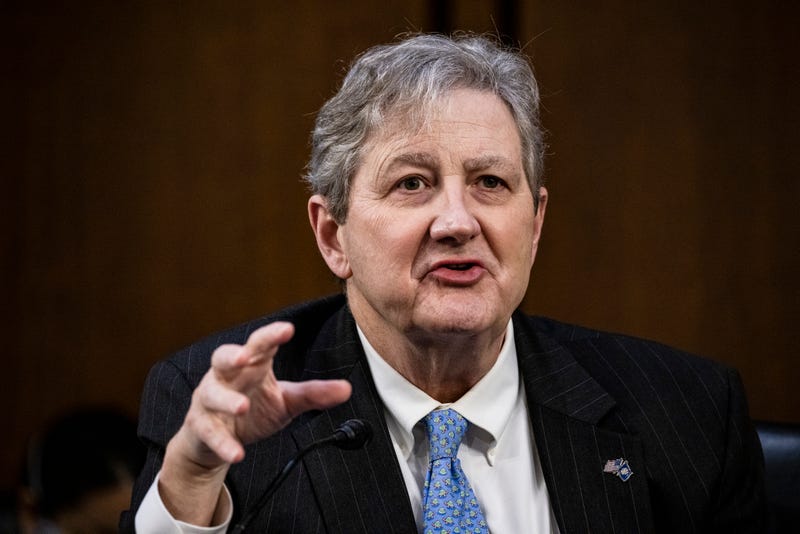
A subtle tension settled over the room, a collective awareness that the day’s events would not be easily forgotten. Cameras continued to record, and reporters scribbled furiously, trying to capture not just the facts but the essence of the moment. Staffers glanced at one another, noting reactions, anticipating questions, and preparing for the inevitable inquiries that would follow.
For Kennedy, this was just the beginning. The room, filled with curiosity, skepticism, and cautious intrigue, was poised for further revelations. Each detail, though factual and neutral, seemed to pull at threads that had been woven tightly for months—threads that, once tugged, could unravel unexpected patterns of influence.
And as he paused, looking across the room at the faces intent on him, the silence was deafening. It was the calm before the next wave, a moment where every observer, both present and watching from afar, understood that the story was far from over.
The moment Kennedy paused, the silence in the hearing room was almost oppressive. Pens hovered above notebooks, cameras tilted slightly to catch the smallest gestures, and every attendee seemed to sense that the next words would matter more than any previous testimony in recent memory.
Yet, the senator’s calm composure gave no hint of nervousness. It was the calm of someone who had seen the storm approaching and had chosen to meet it head-on.
Across the room, lawmakers exchanged subtle glances. Some leaned closer to whisper, their voices low but urgent.
“Did you see that?” one whispered to a colleague. “I’ve never seen him organize information like this before.”
The colleague nodded, eyes narrowed. “Yes… but notice how precise he is. There’s nothing speculative. Every connection, every document—it’s verifiable.”
Not all reactions were positive. A few skeptical members shifted uncomfortably in their seats, folding arms and tapping fingers, silently questioning the relevance of what was being presented. Still, even they could not ignore the meticulous detail laid out before them. The network Kennedy described was intricate, but coherent; layered, yet logical. It painted a picture of influence and decision-making that demanded attention.
Meanwhile, aides moved quietly among the seats, passing notes, exchanging quick whispers, and occasionally handing Kennedy new folders. Each interaction was seamless, a choreography honed over years of high-stakes political maneuvering. For those observing closely, it was almost as compelling as the content itself.
In one corner, a small group of reporters huddled together, phones in hand, live-streaming parts of the hearing while simultaneously typing out summaries. “This is unprecedented,” one murmured. “The way he’s connecting everything—it’s like a blueprint of how decisions really happen behind closed doors.”
Outside the chamber, the buzz was even more immediate. Newsrooms lit up with notifications; editors debated headlines that would capture both the gravity and the neutrality of the unfolding story.
Social media erupted in parallel, hashtags beginning to trend and discussions multiplying by the second. Citizens speculated about the “network of influence” Kennedy mentioned, debating its meaning, importance, and implications. Memes, opinion threads, and analytical posts spread rapidly, amplifying the tension inside the room.
Back inside, Kennedy returned to his folder. “It’s crucial to understand,” he continued, “that none of this is conjecture. These are records, transactions, and decisions, many of which were considered routine at the time. Only by examining the full scope can we appreciate the scale and the interconnections that have formed over months and years.”
The room was silent again, save for the occasional rustle of paper. Kennedy’s words were neutral, careful, and entirely factual—but the implications were undeniable. Patterns began to emerge that suggested not wrongdoing, but a complexity in governance that most had never fully appreciated.
The audience could sense that the details, once fully digested, might reshape how they thought about policy decisions, committee influence, and even the way legislation was drafted.
At the back of the room, a staffer quietly whispered to another: “Do you think people outside realize how intricate this really is?”
“They won’t, not yet,” came the reply. “But when social media starts connecting the dots, it’s going to blow up.”
Indeed, outside the hearing room, that very explosion was beginning. Tweets, posts, and status updates spread snippets of Kennedy’s speech. Political analysts speculated in live broadcasts, journalists dissected the implications for policy and procedure, and commentators debated whether the revelations would prompt further hearings. The story had crossed from Capitol Hill to living rooms across the nation within minutes, illustrating the unprecedented pace of information in the digital age.
Inside the chamber, Kennedy placed another folder on the lectern and opened it carefully. This one contained charts and cross-references that mapped relationships between committees, offices, and decision-making channels.
As he traced the lines with his finger, the network became visually tangible. Lawmakers leaned closer, trying to absorb every link and connection. Some took notes furiously, while others simply stared, awe mixed with apprehension
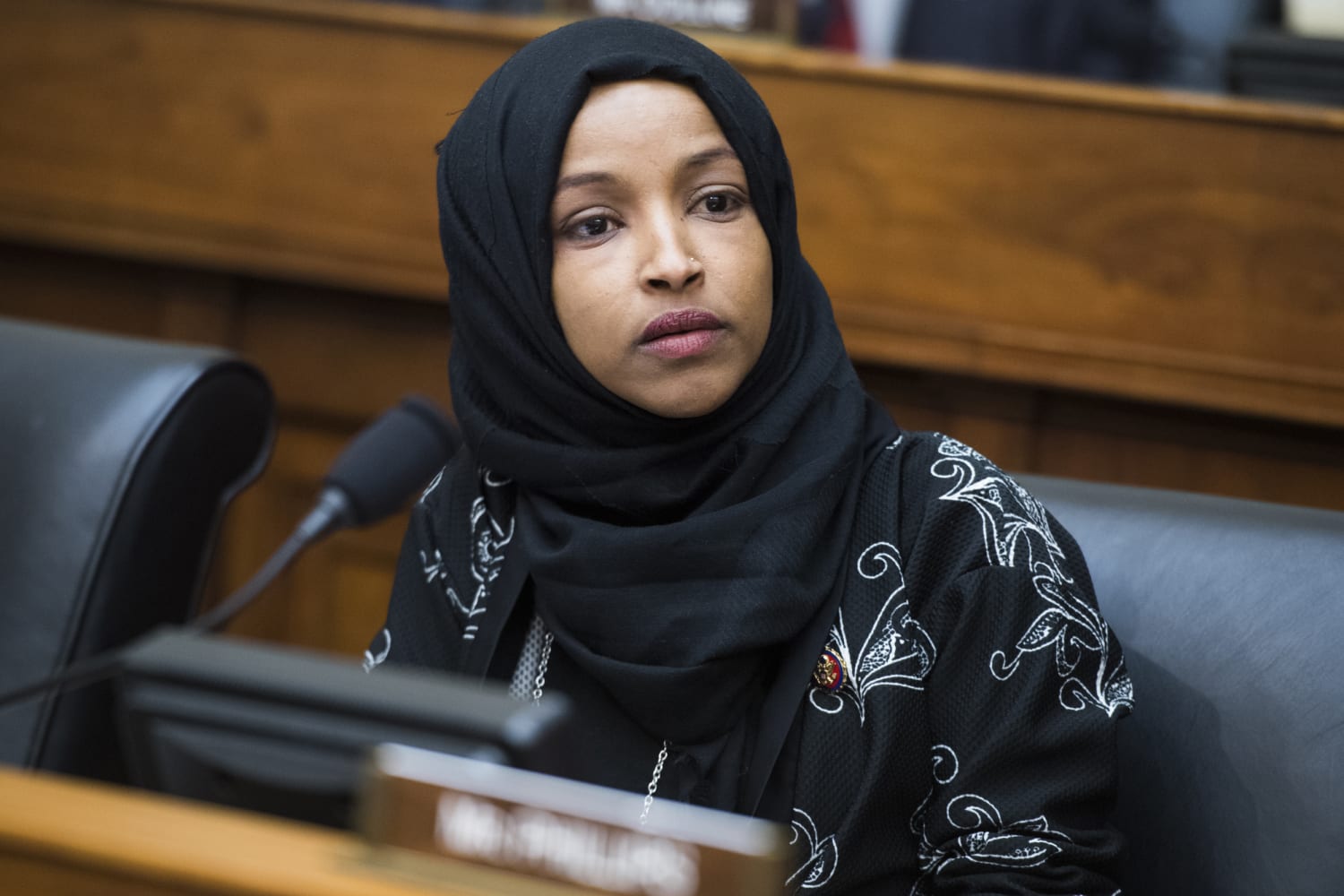
“What this demonstrates,” Kennedy explained, “is not an accusation of misconduct, but a recognition that influence, decisions, and alliances are more interwoven than they might appear. Understanding these patterns is essential for accountability and for ensuring that decisions reflect the best interests of the institution and the public it serves.”
As he spoke, the tension in the room was almost suffocating. The knowledge that Kennedy was about to reach the most critical part of his presentation hung over everyone like a storm cloud. Reporters, aides, and lawmakers alike were aware that the final revelation could reshape their understanding of the processes they had long taken for granted.
Whispers began circulating again, this time louder, more animated. “Do you think he’s going to reveal the last piece?” one reporter asked.
“Definitely,” another replied. “He’s building up to it. Every detail he’s shared so far is setting the stage. We’re on the edge of something big.”
Even among the skeptics, curiosity began to outweigh doubt. People straightened in their seats, pens ready, cameras fixed, and ears attuned to the cadence of Kennedy’s voice. Every word, every gesture, felt like a precursor to something monumental.
As the session continued, the senator paused once more, placing his hands on the lectern and looking around the room. It was a measured, deliberate pause—the kind that demanded attention, that allowed the audience a moment to internalize everything shared so far. The air was charged, heavy with anticipation, as if the room itself were holding its breath.






